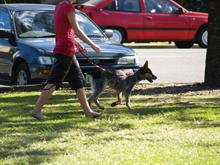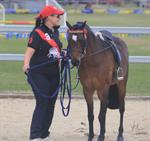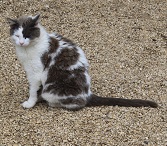
Do you want to learn more about animals and how to care for them?
This course has been designed to help you understand animal health care and basic veterinarian practices. It is a relatively comprehensive foundation for anyone keeping or working with animals (farm, wildlife or pets); and was developed to incorporate most if not all of what would be covered in a typical veterinary assistant's certificate.
Course Duration: 100 hrs
Course Aim: To develop your understanding of basic veterinary and animal health care practices.
Start Date: Start at any time to suit you.
Course Structure
There are 12 lessons as follows:
- Introduction to Animal Health Care
Animal welfare and control; veterinary services; code of practice; transporting animals.
- Common Health Problems in farm animals and pets
Causes of ill health, injury, pains, conditions, nutritional problems; living organisms; parasites; family pets common conditions; dogs; cats; caged birds; aquarium fish; mice; wild animals common conditions; reptiles.
- Animal Behaviour
Communication in dogs; scent; barking; body language; handling cats; bird language; types of behaviour; time orientation; space orientation; territorial behaviour; aggression; horse psychology.
- Signs of Ill Health
Vital signs, the healthy animal; signs & symptoms of diseases; recognising ill health; diagnosis of diseases; taking smears, taking tissue samples; diagnosis and control of different types of diseases including viruses; bacteria; protozoa; parasites; mites; fleas.
- Veterinary Facilities
First aid kits; record management; enclosure for animals; environmental requirements.
- Safety Procedures
Duty of care; lifting heavy weights; reducing back injury, protective equipment; dealing with chemicals; skin penetrating injuries; risk categories; separating animals; disposal of dead/infected tissues; dangerous non-animal wastes; storage and handling of medicines; handling larger animals.
- Administration of Animal Health
Animal insurance; quarantine; importing animals; managing a veterinary office; telephone usage; record keeping; filing information.
- Animal First Aid
Types of wounds; cuts; punctures; tears; treating and cleaning wounds; granulating wounds; stitching a wound; bone and joint problems; broken bones; tendon injury; poisoning; restraining animals during first aid; restraining cats; restraining dogs; restraining horses; restraining cattle; restraining sheep.
- Preventative Health Care
Diet; insect control; dip; vaccinate; avoid stressing livestock; vaccination.
- Routine Health Treatments
Desexing; castration; vasectomy; spaying; tubal ligation; castration of cats, dogs; pregnancy; gestation periods; euthanasia; anaesthesia and analgesia; preparing an animal for surgery; sterilising equipment; castrating a colt.
- Health Problems in Domestic Pets
Burns; urinary tract infections; shock; electrolytes, ticks; reptiles; fish problems.
- Rehabilitation Care
Animal nursing, planning a recovery.
Course Aims

- To be able to describe the scope of services offered by animal care services, including veterinary practices.
- Describe common health problems in various animals, including injuries & diseases.......
- causes of ill health
- problems in family pets
- Explain the natural behaviour of different types of domestic animals in different situations.
- natural behaviour of animals
- problems in wild animals
- behaviour in domestic animals
- Identify common signs of ill health in different animals.
- vital signs
- the healthy animal
- signs & symptoms of disease
- diagnosis & control of diseases
- Describe the purposes of different facilities used in veterinary practice.
- the first aid kit
- enclosures for animals
- Determine safety procedures for a veterinary practice.
- workplace safety
- health & safety for veterinary practices
- Describe different administration procedures in a veterinary practice.
- animal insurance
- legal considerations
- managing a veterinary office
- Describe/select first aid procedures/treatments for different animals in response to common health problems in animals.
- types of wounds
- treatments
- Describe requirements for maintaining good health in domestic animals, including nutrition & preventative medicine.
- preventing ill health
- vaccinations
- To develop an understanding of routine treatments for healthy animals.
- desexing
- managing a pregnancy
- euthanasia
- To develop a broader awareness of health problems and their treatment in domestic pets.
- ticks
- Australian animals
- birds
- reptiles
- fish
- To develop skills in caring for animals prior to, during or after treatment.
- planning a recovery
- animal nursing
EXAMPLES OF WHAT YOU WILL DO IN THIS COURSE
- Research bodies/organisations that are concerned with animal welfare.
- Determine restrictions placed by local councils upon the keeping of pets.
- Determine legal requirements placed upon farmers or pet owners, with respect to animal welfare.
- Observe and compare the behaviour of different types of domestic animals
- Describe methods used for controlling/restraining animals during an examination
- List things as you can that might cause an animals temperature to go too high.
- Contact a government veterinary/agriculture department to research health risks to humans from domestic and farm animal diseases in your country.
- Determine animals that are a threat; what diseases are a more serious threat, and what controls are in place to minimise such problems.
- List animal diseases (exotic and otherwise) that may be contracted by man.
- Design a standard "Patient record" card/form for use by a general practice veterinarian.
Natural Immunity will Allow Animals to Heal Themselves
Often the best care you can give an unwell animal, is to allow it to heal itself. Allow it to rest, and ensure it is comfortable and not stressed by a poor environment or inadequate nutrition. Keep it warm, supplied with fresh water, and feeling safe. In time, the animal's natural defences can often heal a sick animal.
"If an animal is infected with disease organisms, particularly a bacterial or viral infection, it produces antibodies in the blood which engulf and destroy the invading bacteria or viruses.
When all the bacteria or viruses are destroyed, the animal recovers from the disease, the antibodies remain in the blood. If the animal is later exposed to that same infection, it may show slight signs of illness, or no signs at all. This ability to withstand infection is called immunity.
There are four kinds of immunity, as outlined following:

1. NATURAL ACTIVE IMMUNITY
This is the type of immunity acquired by an animal that has been naturally infected by disease organisms and has recovered. Antibodies remain in the animal and it has a natural immunity to that particular disease, often for the rest of its life.
2. ARTIFICIAL ACTIVE IMMUNITY
This is produced by giving an animal a very mild dose and allowing it to produce antibodies to combat the disease. It is done by injecting an animal with a small amount of the bacteria or viruses that cause a disease. The organisms injected into the animal can be alive, using what is called a live vaccine, or they can be dead, using a dead vaccine.
3. NATURAL PASSIVE IMMUNITY
This is the type of immunity acquired by a calf when it drinks its mother's milk. The antibodies pass from the mother's blood into the colostrum. When the colostrum is drunk by the calf, the antibodies pass into the calves blood, giving the calf immunity. This type of immunity is effective only for a short time, and in the case of a calf, immunity against scours acquired through the mother's colostrum lasts for about the first ten days of the calves life. After that period, the calf begins to build its own natural active immunity against scours.
4. ARTIFICIAL PASSIVE IMMUNITY
If an animal is injected with a low level of organisms of a disease, it will produce antibodies to combat that disease. After a few days, it will be able to receive a larger dose of the disease organisms without being seriously affected. This process can be repeated over a period of time until the animal is receiving doses of the disease that would normally kill it. The animal has developed an immunity to the disease, but because this immunity has been acquired by infecting that animal in the first place, it is called artificial immunity.
If blood is taken from an animal who has built up artificial passive immunity, and the serum from this blood is injected into another animal, the second animal will also develop immunity to that disease. Antibodies in the blood of the first animal have been transferred to the second animal, and can be used to destroy the same disease organisms. This transfer of antibodies from the blood of one animal to the blood of another animal is called passive immunity -the same type of immunity as in the case of a cow and its calf."
Comments from Students Studying the Course:
"Yes [I found the course valuable]. I have animals, I am a dog training instructor. I am planning to commence a business providing in-home care to a variety of animals. So I wanted to upgrade my knowledge of animal health. I enjoyed the course and feel I have learned a lot". Beverley Bell -Animal Health Care Student
" I cannot praise the animal health care course highly enough. I have learnt a great deal, far beyond my wishes" G. Kite - Animal Health Care Student
Where Can this Course Lead?
We have seen graduates from this course do all sorts of things. Some have gone on to work as veterinary assistants or in animal welfare establishment; while others have found a career on farms or working with wildlife.
Some use this course as a starting point and go on to further studies in animal husbandry or science.
For others, this course has been all they needed; to provide a fundamental understanding of animals from which they have grown their knowledge and skills through experience and informal learning.
Enrol with us to start your journey towards providing better care to animals.
WHAT NEXT?
Register to Study -Go to panel toward top of this page (right column)
or
Get Advice -Use our FREE COUNSELLING SERVICE to contact a tutor
CLICK TO CONTACT US